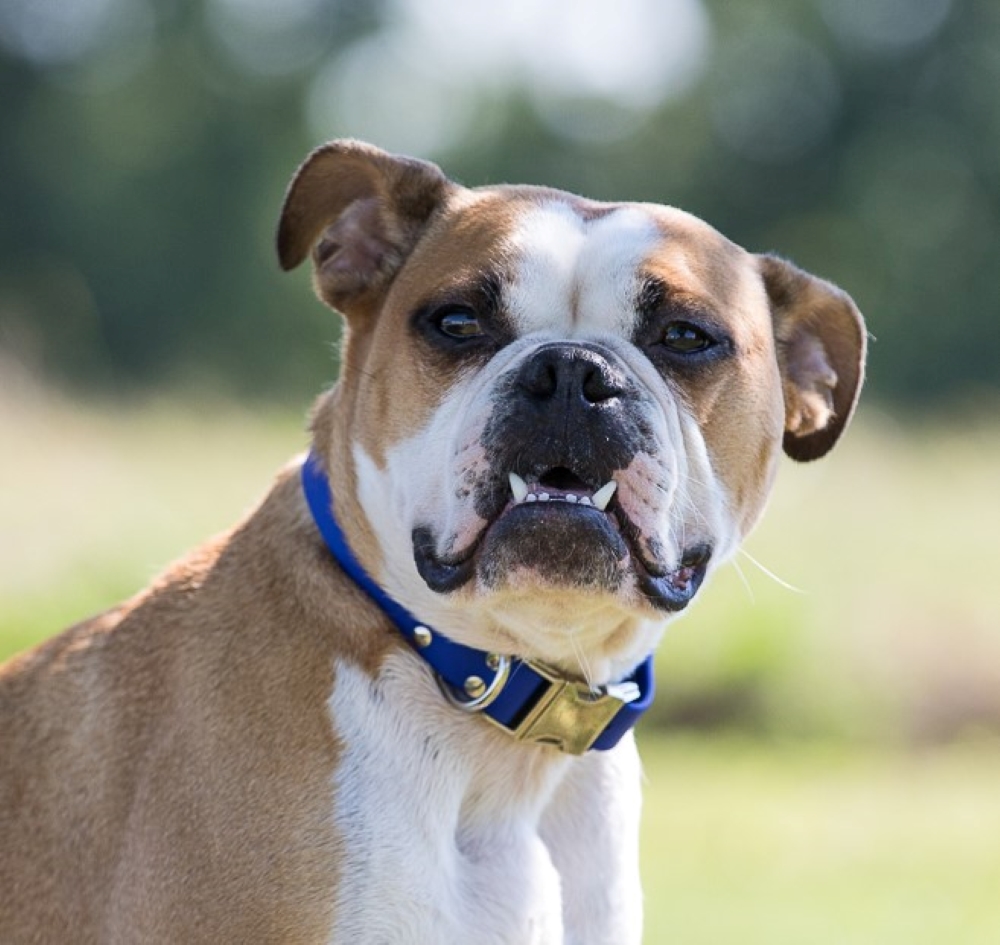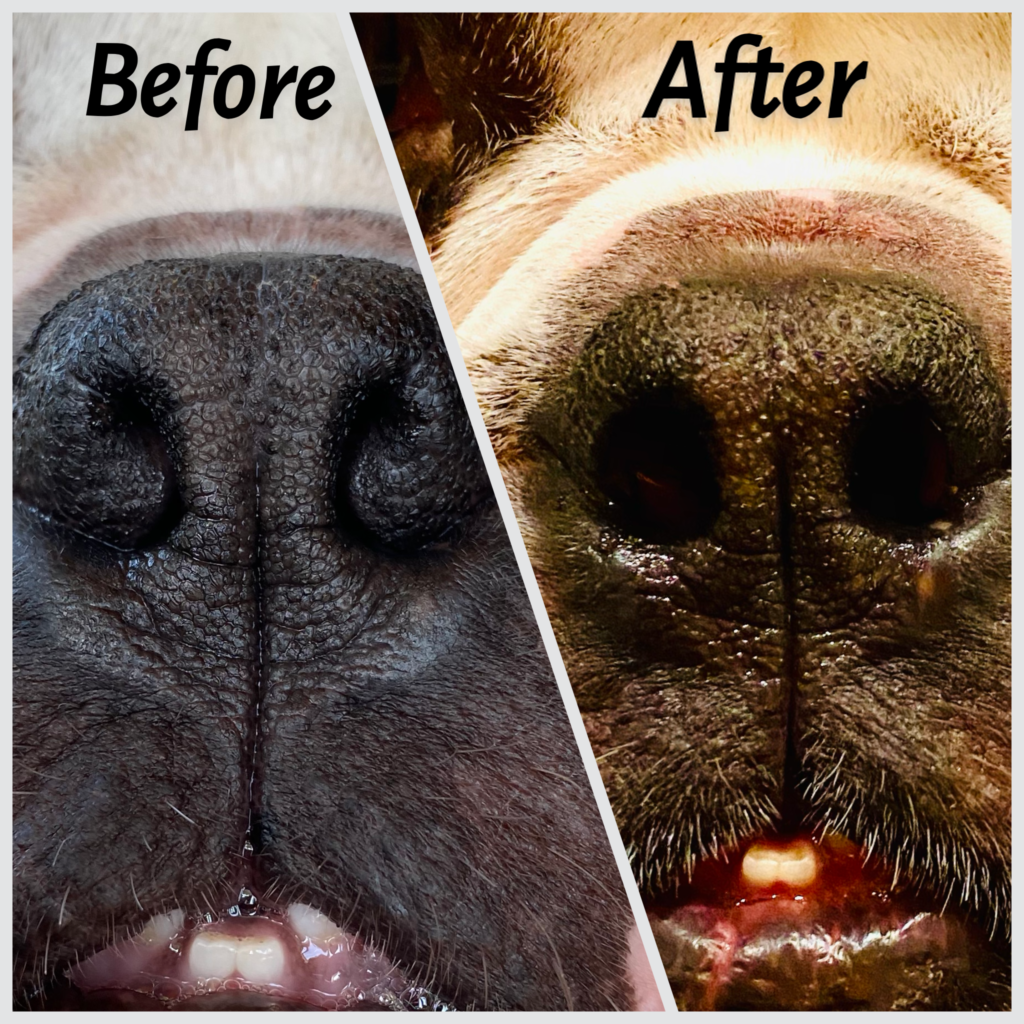It’s a new year, and Tater’s starting it with a new nose. For everyone who knows our rescue dog Tater, you will know that he is brachycephalic, which is the term for “shortened head”. You can see Tater’s head shape clearly in the photo below.

Tater’s Embark DNA results showed that he is a mix of Bulldog, Pug and Boston Terrier.
BOAS and Tater’s New Nose
Many brachycephalic dogs can experience breathing difficulty, stress and heat intolerance during exercise, snoring, choking and collapse to name just a few. Tater was no exception. In fact, the symptoms we were noticing from time to time are part of what is known as Brachycephalic Obstructive Airway Syndrome.
Dogs with Brachycephalic Obstructive Airway Syndrome (BOAS) often benefit from surgery.
But would Tater?
Was he even a good candidate for surgery?
After research, we found a BOAS Veterinary Specialist, Dr. Renee Fleming at Guelph Animal Hospital. Now, many of you might be thinking the name Dr Renee rings a bell. And you would be correct!
It’s the very same Dr. Renee who successfully removed a tumor from my dog Buzz when he was almost 16 years old. You can read the full story of Buzz’s tumor and laser surgery here on my blog in my post from 2012 about “Making the Best Decisions for our Senior Dogs”.
It turned out that Tater was a good candidate, and in December, Dr Renee performed laser surgery. Below you can see his nose before surgery, and just after.
When I decided to write about Tater’s surgery, I contacted Dr. Renee, and she was kind enough to provide an overview that I could share with everyone.
From Dr. Renee:
Tater had a few revisions to his airway, which typically encompass BOAS (Brachycephalic Obstructive Airway Syndrome).
This typically encompasses a few disorders that we can see in short-nosed dogs:
-
- Stenotic nares
- Elongated soft palate
- Everted laryngeal saccules
- Hypoplastic trachea
Traditional airway correction tends to address the first 1/2 +/- 3 issues. More recent thought is that if we correct 1 and 2, 3 corrects itself. There are surgeries (at referral hospitals) to help with a severely hypoplastic trachea, but these are generally reserved for the most severe cases.
Tater had stenotic nares correction. Using laser, we removed the redundant nasal tissue, creating a much wider/rounder external nares opening
Tater had a staphylectomy – using laser, the redundant soft palate tissue was trimmed, using the epiglottis and caudal tonsillar crypts as landmarks.
His laryngeal saccules were not everted, so not resected. With the reduction in negative airway pressure from upper airway correction, the saccules are likely to stay in place moving forward.
Some patients require more advanced surgical procedures. For patients with very narrow pharyngeal openings, we often need to resect (either partial or full) the tonsils, and we can also thin the palatal tissue if it is thick using a partial folded palatoplasty technique. I see this more commonly in older English Bulldogs that have not had airway corrections as pups.
Our hospital uses a surgical laser (not electrocautery) for our airway revisions. Laser will reduce the amount of blood loss and often we do not need to suture the palate at all. This will lead to a tremendously shortened surgical time, with less blood loss and potential for aspiration. Scalpel is also a safe and effective method of correction.
Dr. Renee Fleming DVM
The results of Tater’s surgery were immediate and noticeable. Initially, he wanted to smell everything! We can only imagine that a greater array of scents was now open for him. A few weeks on, and here are Kim’s main observations of the difference.
- You can hear the air moving easily through his open nostrils vs it wheezing through.
- He no longer gulps air like he did prior to surgery.
- He no longer makes all the throat choking noises and weird sounds he made before.
- He can smell and find cookies thrown in the grass easier.
- He does still snore.
I want everyone to know that if you have a dog who is showing any symptoms of Brachycephalic Obstructive Airway Syndrome, then surgery could be an option.
In fact, I would say anyone with a brachycephalic dog who is considering doing sports should at least consider a consult with a specialist to see if their dog is a candidate for surgery.
So we’re heading into 2021 with a transformed Tater, and puppy This! is growing rapidly. We’ll have a lot of fun coming up this year, and you’ll be included. Let me know what you’d like me to cover here on my blog or in my podcast!
Talking about fun, that’s what my second podcast episode for this year is about, so check out Shaped by Dog Episode 57: Why Balance Breaks Fast Track Your Dog Training for an easy way to bring a lot of joy to your training. Once you’ve watched or listened, head over to our YouTube channel and watch the video with me doing a demo of balance breaks with puppy This!.
Today I am grateful to Dr. Renee for writing about Tater’s surgery so that I could share it here for you, and grateful for all Veterinarians who make life better for our dogs.

A photo of best buddies, Tater and This! that I put on Instagram in December.







Started to realise my dog has exercise intolerance in the heat. She is a Cavalier and has a shorter snout than the standard. I do agility but am questioning whether I should be. It has been hot. Did not know you could correct the condition which would help them enormously.. Thanks for the article.
We are currently trying to find someone to perform this surgery on our Fenway. He’s a Boston Terrier and our vet does not do this surgery.
Could you give me a list of questions I should ask when speaking with potential surgeons please? I’m afraid I will forget to ask something very important and we want the BEST care for our lil boy💙
Thank you very much for sharing your experience.
This is really heartwarming. Tater must have been so happy to breathe normally again. Even people like us would get in a lot of trouble when being unable to breathe properly.
Thank you for sharing this valuable information and what a lucky pup that Tater is to have a mom who loves him enough to want the best life possible for him. Kudos to you, Susan. Just another reason you are my favorite all-around trainer.
Thanks for sharing! I wish I had known about this when I had my boxer. She may have benefitted from surgery. Thanks for all that you do, including teaching, educating and loving us and our dogs!
Thanks for sharing this, Susan (and the whole team!). I am a practicing veterinarian and I find that very few people actually recognize that their Brachy dogs struggle to breathe. These pups so often have *amazing* personalities that folks just can’t see that they are really having a hard time. Thanks again for helping more people recognize what is going on for these dogs!
Our 3 year old rescue Staff Bull Adonis just had surgery on Tuesday (12th January) for the same reasons: Stenotic nares and elongated soft palate. Even though the procedures were done by a vet specializing in brachycephalic dog breeds, I was worried that it would take a while for Adonis to recuperate or that complications might arise. However, my concerns were unwarrented. Already a few hours after surgery, he was back to his “old” self – except for his breathing and snorting. I am so happy we had it done, and I think he is too 🙂 Thank you for sharing. I hope other ppl with brachycephalic dogs will look into it.
Warms my heart! Tater is a sweety and deserving. Thank you Susan and team members for giving him a wonderful life.
This is all so good to know. Thank you for sharing!
Tater is one lucky pup!
Wow – I am so happy for the positive outcome. Tater was handsome before – but is super handsome now — and being able to breathe better is a Gigantic Improvement to his Quality of life. I have breathing issues (lung) hence I was very able to sympathise with Tater. — The Before and After Photo shows the obvious improvement.
What a wonderful start to the New Year for Tater. Enjoy all the smells Tater x
Tater is the luckiest dog to have you and the Say Yes crew. Happy New Year!
Suppa duppa!!
Yay tater!!! And i recently used Embark to see if my dog has DM and what a shock on the results..he is a chimera! So they told me they couldn’t give me any genetic results.
Yay for Tater! He found an amazing new hone on all levels.
Tater must love his new ability to pull in all those wonderful smells. I bet he will love it even more in the spring..
Tators new nose looks great and he must feel so much better. Also first time I’ve seen your new pup
Lovely beginning and new year for Tater! So glad Dr. Renee was able to help him. More smells and happy play without obstruction of his breathing. Best wishes!
Loved it. So glad that could be and was done. I can only wish more rescue dogs could be blessed like taht
Very interesting account. I am going to forward this to our oldest granddaughter who is in her first year as a practicing vet, graduating from U of Illinois Vet School last spring. As a casual dog lover and owner, my understanding is that breathing problems are not uncommon in those breeds that I have heard referred to as “push face” short headed breeds. Not sure if that’s common terminology that’s used, but its the pugs, BT, boxers, type of head ad noses that you refer to. Is this a true breed characteristic or just exasperated by breeders and show ring judges? Always the eternal, question!! That’s for the information and the best to Tator.
Awesome. Happy sniffies, Tater!
Interesting and very happy for Tater, Thanks for sharing. Maybe one day we will stop breeding dogs who are born with these health issues.
Suggestion for future topic, is it possible to develop the IYC game to prevent poop eating? My 13 month old MAS has done this since I brought him home. I have taught him to sit and wait for me to pick it up. It’s never left lying around. But if he thinks he can get away with it he will. Last week he ate the whole ‘log’ before I could pick it up. He mostly eats his own but isn’t adverse to snacking on other dogs. I’m trying to learn not to let this distress me!! Thank you.
SOO happy for you, and TATER! You must be relieved that you don’t have to worry about Tater having trouble breathing/ Passing out?? And special that you can see him having fun learning what everything smells like! Glad all went well- surgery on my” furry children” always makes me nervous. Happy, healthy New Year! Carole
I just love that you shower as much care on your rescue Tater as you do on your high bred agility dogs Tater has a strong following and has certainly earned his keep as a demo dog where we see progress not perfection as in our own family dogs, especially our rescues as my Zull
Thank you❤️
Thanks for sharing. It is good to know that these poor pups can be helped. I think its terrible that dogs are bred for physical defects so they can be “fashionable”.
May I ask whether this affected or improved Tater’s capacity for exercise? My friend has a young French bulldog who, I’m told, cannot exercise long because she cannot breathe well. Thank you.
Well, he isn’t really a big “exerciser” by nature, lol. It will be interesting to see in the summer how much better he copes and I can only imagine it increases his exercise tolerance as you can now literally hear the air flowing through his nostrils vs wheezing and he isn’t choking all the time. I know there are some brachycephalic dogs that can hardly breath at all, I would definitely recommend they get a consult to discuss their options.
So Happy the surgery helped him and Loved the Christmas card where you show This! Kissing Tater, Thank her for would Love to do that to him too and all your babies. So Happy it went Great ❤❤❤
You are an awesome part of the Tater fan club, Nancy!
I have caught bits of Tater’s story, but never heard the whole thing…I wonder if you have a blog post that tells the story?
That’s a good idea, Katie! In the meantime, Susan shares how Tater got his name in a podcast, here’s the link to the episode where you can watch or listen and get the transcript:
https://dogsthat.com/podcast/13/